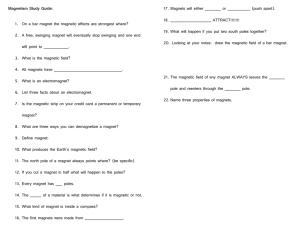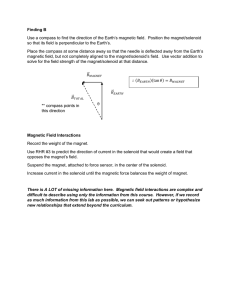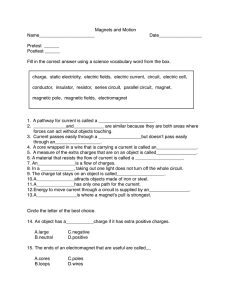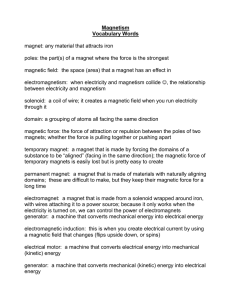Episode 411-2: Brush up on magnetism (Word, 43 KB)
advertisement
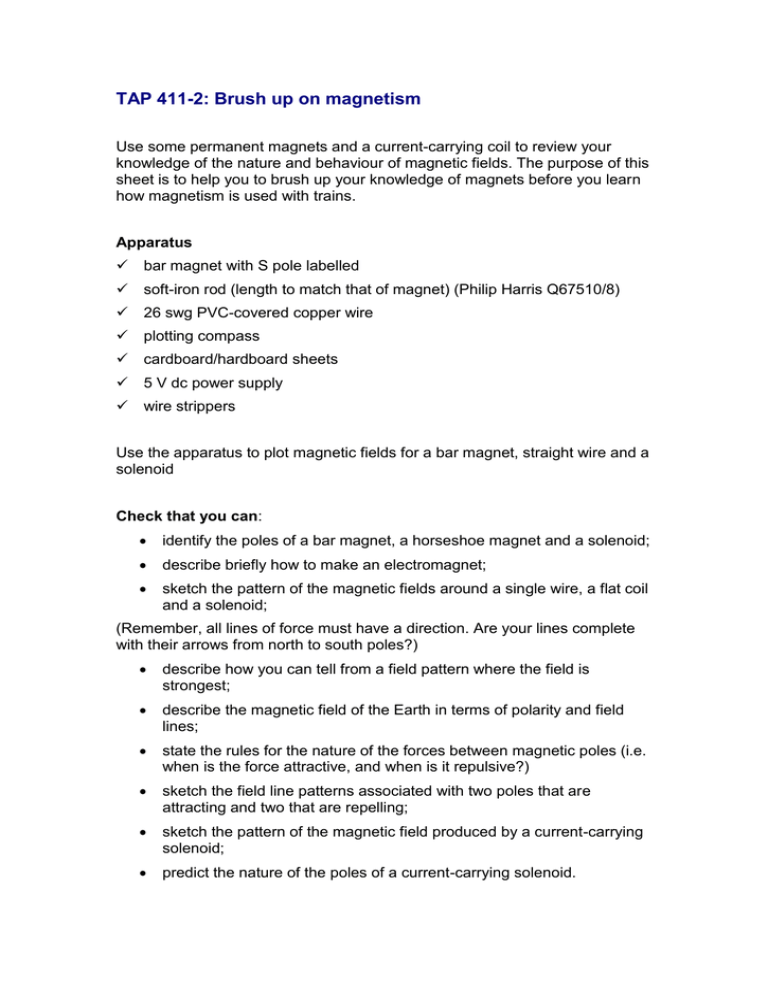
TAP 411-2: Brush up on magnetism Use some permanent magnets and a current-carrying coil to review your knowledge of the nature and behaviour of magnetic fields. The purpose of this sheet is to help you to brush up your knowledge of magnets before you learn how magnetism is used with trains. Apparatus bar magnet with S pole labelled soft-iron rod (length to match that of magnet) (Philip Harris Q67510/8) 26 swg PVC-covered copper wire plotting compass cardboard/hardboard sheets 5 V dc power supply wire strippers Use the apparatus to plot magnetic fields for a bar magnet, straight wire and a solenoid Check that you can: identify the poles of a bar magnet, a horseshoe magnet and a solenoid; describe briefly how to make an electromagnet; sketch the pattern of the magnetic fields around a single wire, a flat coil and a solenoid; (Remember, all lines of force must have a direction. Are your lines complete with their arrows from north to south poles?) describe how you can tell from a field pattern where the field is strongest; describe the magnetic field of the Earth in terms of polarity and field lines; state the rules for the nature of the forces between magnetic poles (i.e. when is the force attractive, and when is it repulsive?) sketch the field line patterns associated with two poles that are attracting and two that are repelling; sketch the pattern of the magnetic field produced by a current-carrying solenoid; predict the nature of the poles of a current-carrying solenoid. Now read the article and answer the questions. For the past 50 years or so, a system known as the AWS (Automatic Warning System) has used magnetic effects to provide train drivers with an indication of the state of signals. The system is gradually being replaced by ATP (Automatic Train Protection). Under the front of the train is a pivoted magnet set between the open ends of an iron C-core. This C-core has a coil wound around it so that it can be made into an electromagnet by pressing a button in the cab (see below). Any deflection of the pivoted magnet is detected by a sensor and will set off a bell or a horn inside the cab. This deflection is caused by a pair of magnets embedded in the space between the rails. One is a permanent magnet and the other an electromagnet arranged as in the diagram below. The electromagnet is switched on only when the signal is green. Rotation of the pivoted magnet then causes a bell to ring in the cab for 2 seconds. Any other signal aspect produces a different rotation of the magnet and makes a horn sound instead until the driver responds by pressing the acknowledgement button. Failure to respond brings the train’s brakes on automatically. Questions 1 Explain the different rotations of the pivoted magnet in response to a (i) green and (ii) red or yellow aspect signal. 2 What does pressing the acknowledgement button do to the pivoted magnet? Practical advice This practical activity is intended to ensure that students are familiar with some basic things about magnetism before they tackle more advanced work. Unless you are very sure of your students’ prior knowledge, avoid the temptation to leave it out. Answers and worked solutions 1 (i) When the signal is green the pivoted magnet’s north pole first dips down towards the permanent track magnet’s south pole and then reverses as it moves on towards the electromagnet’s north pole. The pivoted magnet’s south pole then dips down towards the electromagnet’s north pole, and reverses again as it moves away to regain its original orientation in the C-core. (ii) When the signal is red the pivoted magnet’s north pole dips down towards the permanent track magnet’s south pole and then reverses as it moves on. It now has the opposite orientation in the C-core to what it had on approach. With the electromagnet not energised no further rotation takes place. 2 It provides a magnetic field in the C-core to bring the pivoted magnet back to its original orientation. External reference This activity is taken from Salters Horners Advanced Physics, section TRA activity 8




